NATO air defense system in Europe. Part 1
After the start of the “Cold War” and the formation of the North Atlantic Alliance, the countries that belong to it began to question the provision of anti-aircraft defense facilities and military contingents located in Western Europe. In the middle of the 50s, the territory of the Federal Republic of Germany, Belgium, Denmark, the Netherlands and France was within the reach of the Soviet Il-28 front-line bomber. The combat range of the Tu-4 long-range bombers made it possible to deliver nuclear and conventional bomb strikes throughout Europe. The threat to NATO facilities in Europe has increased even more since the introduction of the Tu-1954 long-range bomber into the USSR in 16 in the year.
Initially, the air defense of the "Old World" was provided by fighter aviation. In the early 50s, these were mainly subsonic fighters: the American F-86 Saber and the British Hunter. In the land contingents of the American and British occupation forces in Germany and at the military bases of NATO countries, there were several hundred anti-aircraft guns that were controlled by radar, these were the American 75 mm M51, 90 mm M2 and the British 94 mm 3.7-Inch QF AA.
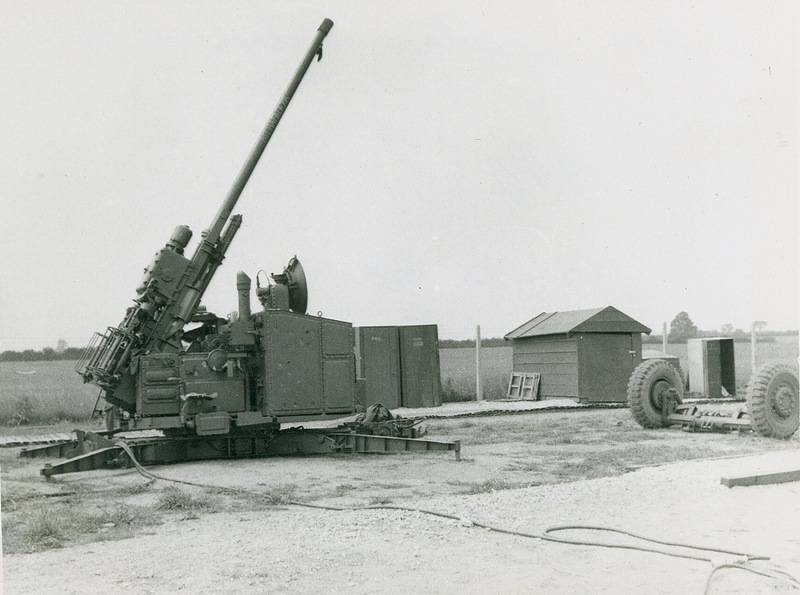
However, as the speed increased and the number of Soviet jet bombers increased, fighters of the first post-war generation and anti-aircraft guns could no longer be considered an effective means of providing air defense. Towards the end of the 50s, supersonic and all-weather interceptors appeared in NATO fighter squadrons, and anti-aircraft missile systems in ground air defense units.
The first NATO mass supersonic fighters in Europe were the American F-100 "Super Sabyr" and the French "Super Mister." In 1956, the Votour IIN double all-weather interceptor was commissioned in France, and the Javelin in the UK. On the French and British interceptors, a powerful American radar was installed, which made it possible to detect targets day and night in all weather conditions. The interceptor was aimed at the target by the commands of the operator located in the rear cockpit, where the radar indicator and control equipment were installed.
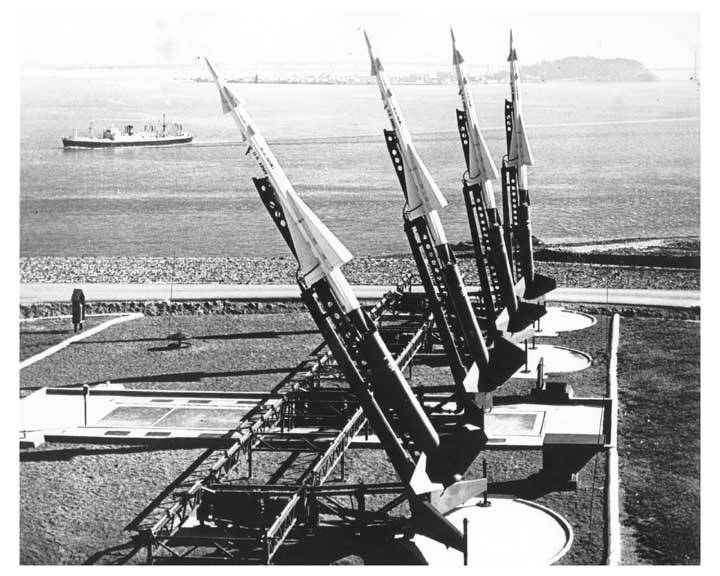
In 1953, in service with the US Army, the medium-range air defense system MIM-3 Nike-Ajax was adopted. The defeat range of the Nike-Ajax missile at medium altitudes was 48 km. By 1958, more than 200 fire batteries were built, most of them were deployed in the United States, but after the appearance of a more advanced MIM-14 complex, Nike-Hercules, Nike-Ajaxy were transferred to the air defense units of Greece, Italy, Turkey, the Netherlands and Germany. Compared with the Nike-Ajax air defense missile system with liquid-propelled missile systems, the Nike-Hercules complex solid-propellant rocket had more than double its target range and did not require refueling with toxic fuel and caustic oxidizer. However, unlike the first mass Soviet S-75 air defense system, the American Nike-Ajax and Nike-Hercules were in fact purely stationary complexes, their relocation was difficult, and equipped capital positions were required for deployment.
To protect the RAF airbases in the UK, Thunderbird SAMs were launched from the 1959 (launch range in the 1 MK-40 km version), and from the 1964, they covered the garrisons of the Rhine Army in the Federal Republic of Germany. After adjusting to the required level of reliability and improving combat performance, several Bloodhound Mk II air defense missile systems with a launch range of 80 km were deployed to protect British targets on the continent. At the end of the 1967, the Tigercat short-range air defense system was adopted in the UK in order to replace the 40-mm anti-aircraft machine guns in units of military air defense systems.
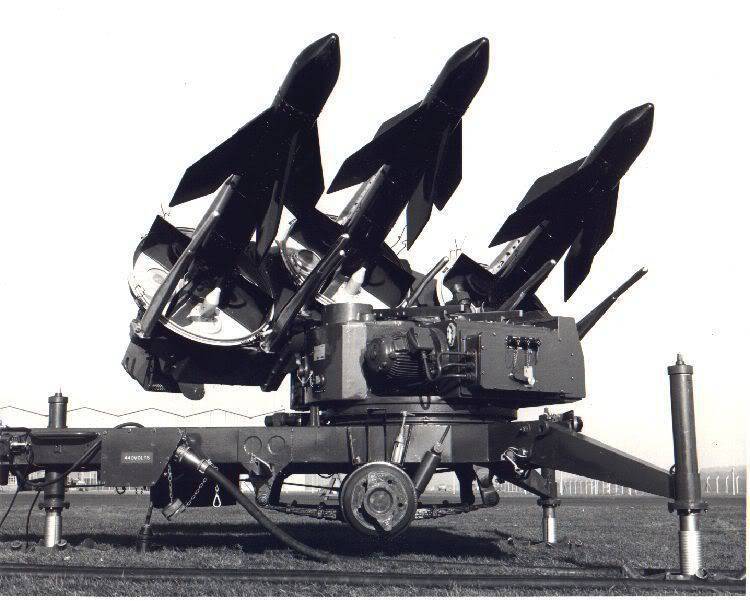
In turn, low-altitude MIM-60А HAWK SAM systems with a target range of 23 km began to arrive for the armament of the US Army anti-aircraft units in the middle of the 25-s. Unlike the Nike family complexes, all the components of the Hawk air defense system had good mobility. Subsequently, the Hawk was repeatedly subjected to modernization, which ensured its long life and maintenance of combat performance at the required level. In addition to the US armed forces, the Hawk air defense system was available in Belgium, Greece, Denmark, Italy, Spain and the Federal Republic of Germany.
In the second half of the 60s, NATO air forces began to receive en masse supersonic interceptors: Lightning F.3, F-104 Starfighter, Mirage III and F-4 Phantom II. All these planes had their own radar and guided missiles. By that time, a wide network of hard-surface airfields was created in Western Europe. All the airbases, where interceptors were permanently based, had concrete shelters for airplanes.
In 1961, a unified NATO air defense system in Europe was created. It consisted of four air defense zones with its own control bodies: Northern (operational center in Kolsos, Norway), Central (Brunssum, Netherlands), Southern (Naples, Italy) and Atlantic (Stanmore, United Kingdom). The boundaries of the first three zones coincided with the borders of the North European, Central European and South European theater of military operations. Each zone was divided into districts and divided into sectors. The air defense regions coincided geographically with the zones of responsibility of tactical aviation commands. The command of the joint air defense forces was carried out by the Supreme Commander of the joint armed forces of NATO in Europe through his headquarters. The commanders of the NATO Combined Forces in the theater of military operations guided the forces and means of air defense in areas of responsibility, and the commanders of tactical aviation commands in the areas of air defense.
The integrated air defense system in Europe relied on zonal operational control centers, on regional centers, control and warning posts, as well as airborne radars. The control was based on the Neji automated warning and guidance system, which was launched in 1974. The "Nage" system was intended to alert the structures included in it about the air enemy and to control the combat forces of the combined NATO air defense system. With its help, it was possible to intercept air targets flying at a speed of about 2M, at altitudes of up to 30 m. The air defense forces of 000 countries were included in the system. After the country's withdrawal from the military structure of NATO, the armed forces of France had their own warning network, but used the "Nage" data. The Nage system received information from more than 14 radars extending in a chain from the north of Norway to the eastern borders of Turkey for 80 km. 4800 posts located in key areas of Western Europe were equipped with high-speed computers and automated means of transmitting information. About 37 people were involved in the operation and maintenance of the "Nage" system in the mid-70s. At the beginning of the 6000s, the 80th naval radars were included in the Nage system. fleet USA in the Mediterranean Sea, AWACS AWACS aircraft, as well as radar stations in Spain.
The main early warning radar of the Nage system was a stationary three-coordinate station Palmiers-G of French production operating in the centimeter range. This station with a power pulse 20 MW possessed high noise immunity and ensured the detection of high-altitude aerial targets at a distance of up to 450 km. The Palmier-G radar has formed a multipath in the vertical plane of the diagram, the rays of which are arranged with some overlap one above the other, thus covering a wide viewing sector (from 0 to 40 °). This ensured accurate determination of the height of the detected targets and high resolution. In addition, using a similar principle of beam formation with separation in frequency, it was possible to determine with greater certainty the angular coordinates of the target and to carry out its reliable tracking.
In 1975, the Palmiers-G 18 radar was deployed in Europe. The locations for the radar were selected on the basis of the maximum possible review of the airspace and the possibility of detecting targets at low altitudes. Preference was given to the location of radar in a deserted area on natural elevations. In addition, two-coordinate radar detection of air targets AN / FPS-20 and AN / FPS-88 with a detection range of up to 350 km, as well as altimeters S2G9 and AN / FPS-89 were included in the Nage system.
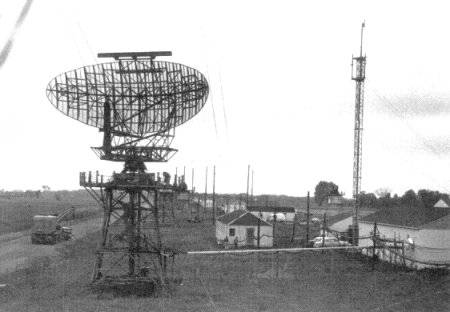
These radars, according to the plan of the NATO command, were to ensure the maximum possible range of detection of air targets east of the borders of the NATO countries. In addition, in the event of a military danger, mobile radar stations deployed in towed vans and in a motor vehicle chassis were pushed into prearranged areas. The NATO command reasonably believed that most of the fixed stations whose coordinates were known to the Soviet command would be destroyed in a matter of hours after the outbreak of hostilities. In this case, mobile radars, even if they possess the worst characteristics of the detection range, should at least partially close the gaps formed in the radar field. For this, a number of mobile airspace viewing stations were used. In 1968, the AN / TPS-43 radar, operating in the 2,9 - 3,1 GHz band, with the detection range of high-altitude aerial targets up to 400 km, entered service with the US Army.
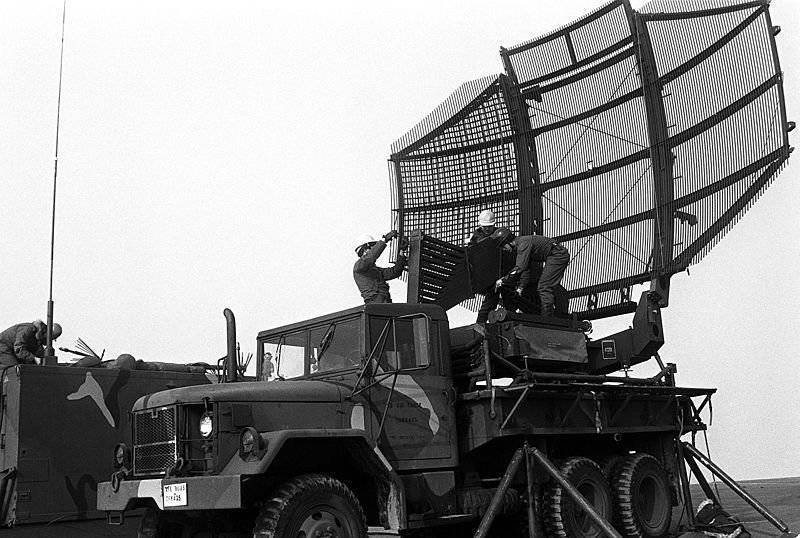
The most compact was the radar AN / TPS-50, operating in the 1215-1400 MHz band. Its range was 90 — 100 km. All the equipment of the station could carry seven soldiers. Deployment time - 30 min. In 1968, an improved version of this station was created - AN / TPS-54, transported in a van. Radar AN / TPS-54 had a range of 180 km and identification equipment "friend or foe".
At the end of the 70-s, all the fighter-interceptor bases at the disposal of the European command of NATO air defense and the medium-range and long-range air defense systems were linked to the “Nage” information system. The northern zone, which includes the Norwegian and Danish air defense areas, had the 96 PU of the Nike-Hercules and Hawk missiles and around the 60 interceptor fighters.
The central zone controlling Germany, the Netherlands and Belgium was the largest. The central zone's air defense provided: the 36 divisions of the Nike-Hercules and Hawk systems to the armed forces of the United States, Belgium, the Netherlands and the Federal Republic of Germany. In the British “Rhine Army” there were 6 batteries for the “Bloodhound” air defense system. In total, in the central zone there were more than 1000 launchers. However, at the end of the 70, the British command decided to withdraw all the SAMs from Germany, they were returned to England to provide air defense systems for nuclear submarines and strategic bomber airfields. In addition to the air defense system in the Central Zone housed over 260 interceptor fighters. The greatest combat value for intercepting Soviet bombers was represented by the 96 of the American F-4 with the AIM-7 Sparrow missiles and the British 24 of the French FX3 with the Red Top missiles.
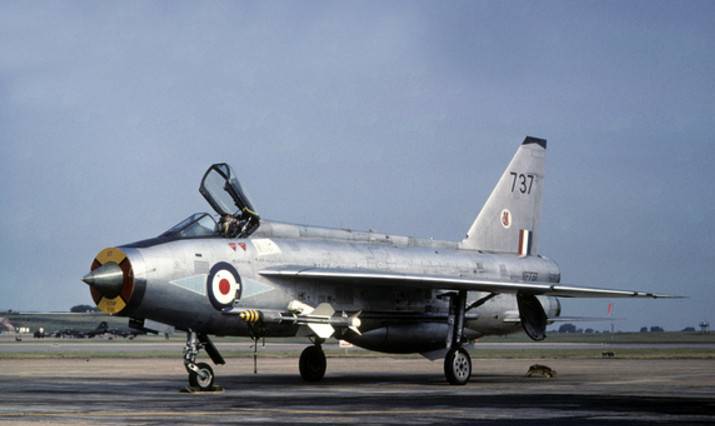
During the years of the “Cold War” in Germany, the greatest density of positioning of air defense missile systems was observed among all NATO countries. To protect against bombing attacks of administrative and industrial centers, as well as the main grouping of NATO forces in Germany, the air defense system was deployed at two lines of defense. Near the border of the GDR and Czechoslovakia there was the first line of positions of low-altitude hawk SAM systems, and in the 100 — 200 km behind it — the Nike-Hercules air defense system. The first belt was designed to hit air targets breaking through at low and medium altitudes, and the second at high altitudes.
The Atlantic zone covered the territory of Great Britain, as well as the Faroe and Scottish islands. The British Isles were protected by several batteries of the “Bloodhound” air defense system and six squadrons of fighter-interceptors. The Southern zone included Italy, Greece, Turkey and part of the Mediterranean basin. The Italian air defense forces had 3 of the Nike-Hercules (108 PU) division and 5 squadron of F-104 fighters (around 100 aircraft). In Turkey and Greece, there were 8 squadrons of fighter-interceptors (140 aircraft) and 3 of the Nike-Hercules (108 PU) division. The maneuver of the air defense forces in the area could be carried out with the help of five divisions of the Hok air defense missile system (120 PU) of the ground forces of Italy and Greece. The island of Cyprus housed the battery of the air defense system "Bloodhound" and the interceptor squadron "Liteinig" F.3. All in all, NATO’s air defense zone in the South was above 250 interceptor fighters and 360 SAM missiles.
In the middle of 70's, NATO's unified air defense system in Europe had over 1500 SAM missiles and more 600 interceptor fighters. In 70-80-ies in the NATO countries for the immediate protection of ground units from bomber and fighter-bomber aircraft developed short-range air defense systems. In the British air defense units of the ground forces in the 1972, the Rapier complex began to arrive. This air defense system had a semi-automatic radio command guidance and was intended to replace the outdated low-performance air defense system "Taygatet." The air defense system "Rapier" of the first versions could hit air targets at a distance of 6800 meters and at an altitude of 3000 meters. In addition to the British army, the air defense system "Rapier" was supplied to the armed forces of other member countries of the alliance. To ensure the defense of US air bases in Europe, several complexes were purchased by the US Department of Defense.
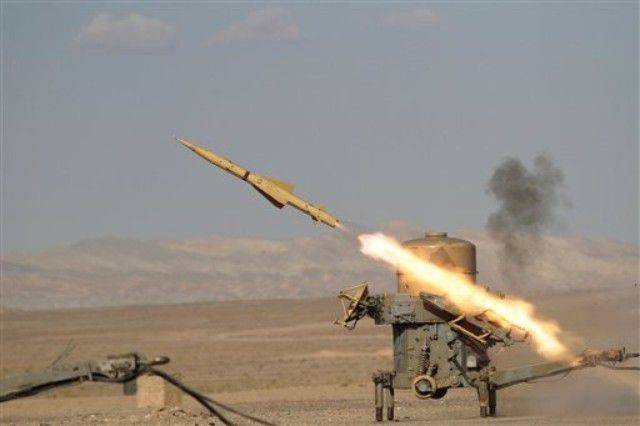
Almost simultaneously with the British air defense system "Rapier" in France, the mobile short-range air defense system Crotale was created. It was designed to combat air attack in the range of medium and low altitudes. The complex was created according to the technical task of the French Ministry of Defense to directly cover the combat formations of troops and provide air defense of strategically important objects, headquarters, strategically important radar stations, launching positions of ballistic missiles, etc. The range of air targets is 0,5-10 km, the height of the lesion is up to 6000 meters. In the complex "Crotal" radar detection equipment and self-propelled launcher with guidance station are separated on different machines.
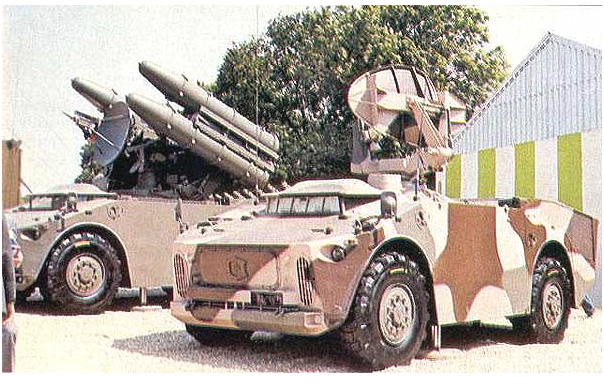
In 1977, the air defense units of the Land Forces of Germany and France began to receive the short-range mobile air defense system "Roland". The complex was developed jointly by the French company Aerospatiale and the German Messerschmitt-Belkov-Blom. The radio command missiles of the Roland complex are capable of destroying targets flying at speeds up to 1,2 M at distances from 0,5 to 6,3 km and at altitudes from 15 to 5500 meters. LAW "Roland" was located on the wheelbase of heavy trucks of all terrain and various tracked chassis.
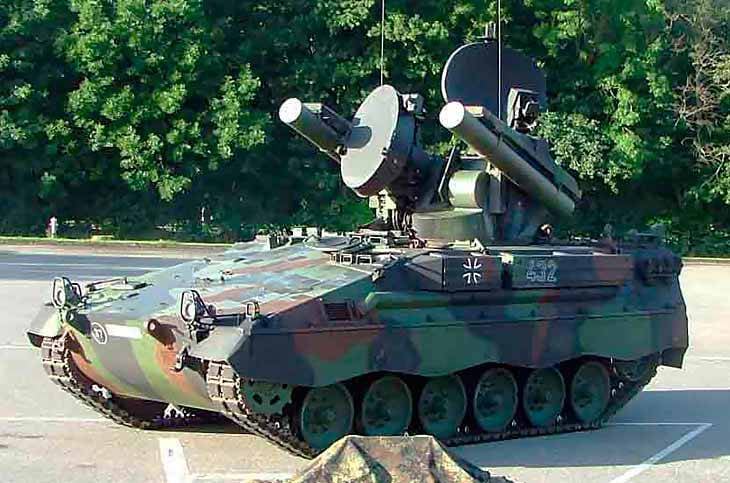
A few years earlier than in Europe, in 1969, the self-propelled MIM-72A Chaparral air defense system was adopted by the American army. In order to save time and financial resources, the designers of the company Lockheed Martin Aeronutronic used AIM-9 Sidewinder missiles with TGS in this complex, placing them on the chassis of a tracked carrier. Chaparrel had no own radar means of detecting the air defense missile system and received target designation on the radio network from AN / MPQ-49 radar with a target detection range of about 20 km, or from observers. The guidance of the complex was carried out manually by the operator, visually tracking the target. The launch range in conditions of good visibility on the target, flying at a moderate subsonic speed, could reach 8000 meters, the height of the lesions 50-3000 meters. The disadvantage of the Chaparrel air defense system was that it could mainly fire jet aircraft in pursuit. This means that the shelling of a combat aircraft with anti-aircraft missiles, as a rule, was carried out after he dropped bombs. At the same time, more expensive and complex complexes with radio command missiles, developed in Europe, could fight targets flying from any direction.
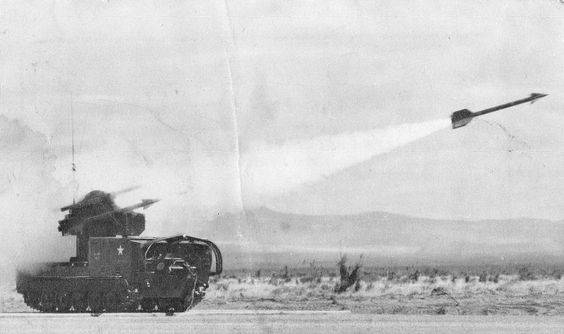
The towed and self-propelled air defense missiles, designed to cover individual objects, such as command posts, air bases and troop concentrations, had a relatively short range (from 0,5 to 10 km) and could fight air targets at altitudes from 0,05 to 6 km.
In addition to air defense systems in the NATO countries, a number of self-propelled anti-aircraft artillery self-propelled guns, capable of accompanying troops on the march, were put into service. In the US, it was the M163 ZSU, also known as the Vulcan Air Defense System. ZSU "Volcano", adopted in the 1969 year, was a 20-mm small-caliber anti-aircraft gun, developed on the basis of an aircraft gun, mounted in a rotating turret on the chassis of a tracked armored M113. Gun ammunition was 2100 shells. The target range of firing at air targets to 1500 meters, although some sources indicate the range to 3000 meters. Reach for height 1200 meters. Fire control was carried out using an optical sight with a computing device, a radio range finder and a night sight. When an airborne target enters the affected area, the gunner-operator of the Zulu Vulkan, depending on the flight parameters and the nature of the target, can fire at it with short and long bursts of 10, 30, 60 and 100 shots.
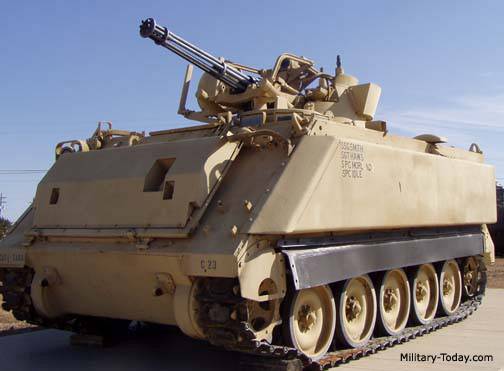
The 20-mm gun with a rotating barrel unit had a variable rate of fire. Fire with a rate of 1000 rounds per minute is usually fired at ground targets, and with a fast pace of shooting 3000 rounds per minute, air targets are used. In addition to the ZSU, there is also a simplified and lightweight towed version - M167, which was also in service with the US Army and exported. Back in 70-e years, experts pointed out a number of significant shortcomings ZSU "Vulkan". Thus, the installation initially did not have its own radar sight and a station for detecting air targets. For this reason, she could only fight with visually visible targets. In addition, the gunner was located in the open at the top of the tower, which increased the vulnerability and reduced reliability due to the influence of meteorological factors and dust.
ZSU "Volcano" in the US armed forces organizationally reduced together with the air defense system "Chaparrel." In the US Army, the Chaparrel-Vulcan anti-aircraft division consisted of four batteries, two batteries with the Chaparral air defense missile system (12 machines per each battery), and two others - with the ZNX М163 (12 in each battery). The towed version of the M167 was mainly used by air assault, airborne divisions and the Marine Corps.
The combat order of a division was built, as a rule, in two batches. The first line consisted of fire batteries ZAK "Vulkan", the second - the SAM "Chaparel". When escorting troops on the march, ZSU is located in marching columns throughout the depth. Up to three radar detection of low-flying air targets AN / MPQ-70 or AN / MPQ-32 were allocated to each battery from the middle of the 49-x.
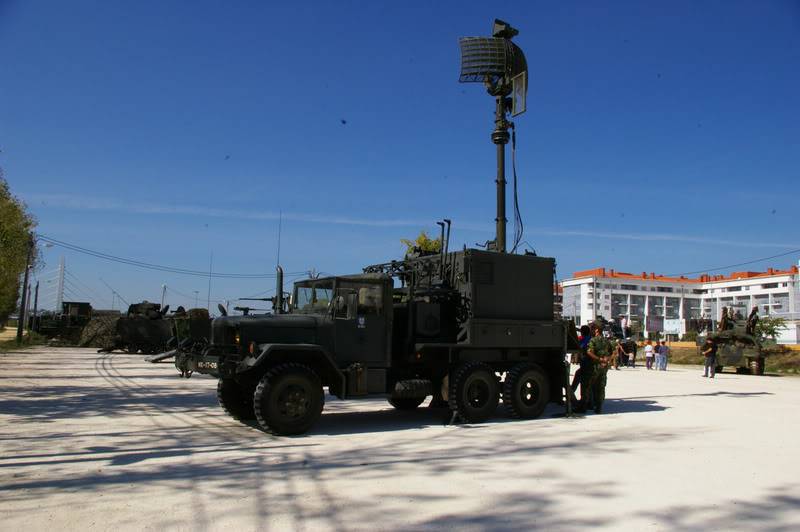
The antenna system of the AN / MPQ-49 station is mounted on a telescopic mast, the height of which can be adjusted depending on external conditions. This makes it possible to raise the receiving-transmitting antenna over the folds of the terrain and trees. It is possible to remotely control the radar at distances up to 50 m using the remote control. All equipment, including communication AN / VRC-46, is located on the all-wheel drive truck. The American command used this radar operating in the 25-cm range for the operational management of military air defense assets.
At the end of the 80, part of the Vulkan ZSU was upgraded as part of the PIVADS program. The program to improve combat performance provided for the introduction of a digital fire and radar control system, as well as the introduction of the new Mk149 armor-piercing projectile, with a range of effective fire increased to 2600 meters.
In the 50s in France on the basis of tank AMX-13 created a quad 12,7-mm anti-aircraft gun, in its combat characteristics similar to the American ZSU Maxson Mount, released during the Second World War. The French 12,7 mm ZSU was popular in the army, but already in the 60s it categorically did not meet modern requirements. In this regard, on the basis of AMX-13 in the late 50s, a number of ZSUs with 20-mm and 40-mm anti-aircraft guns were created. However, due to the fact that these ZSU were not equipped with a modern fire control system, they did not arrange the military. At the end of 1969, the ZSU AMX-13 DCA entered service.
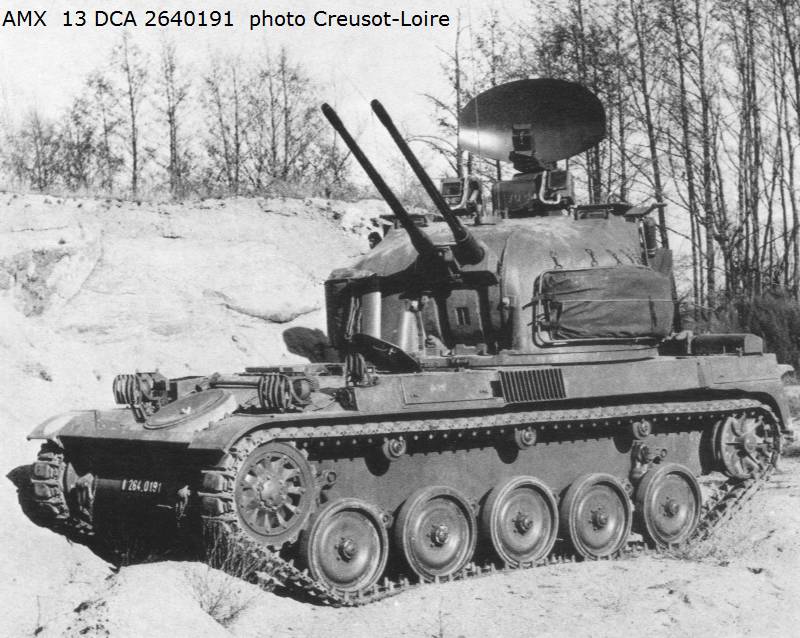
In the closed steel tower of this anti-aircraft self-propelled gun, the Spark 30-mm anti-aircraft gun HSS-831A was mounted with the total rate of fire of 1200 rounds per minute. The range of effective fire on air targets reached 3000 meters. The ammunition of each gun - 300 shells. Depending on the situation and the nature of the target, the gunner has the opportunity to choose the shooting mode: single, the queue in 5 or 15 shells or fully automatic. Targeting is carried out with the help of optical sights of the commander and the gunner according to the data obtained from the pulse-Doppler radar DR-VC-1A, with the detection range of air targets 12 km. In the stowed position, the radar antenna was folded over the tower. The fire control system also includes an analog computing device that calculates elevation and lead angles. The car turned out quite light, its weight was a little over 17 tons.
Prior to the start of the 90, AMX-13 DCA was a regular air defense weapon of the French mechanized divisions and was in service with their anti-aircraft artillery regiments. In general, the French, in comparison with the Vulkan ZSU, managed to create an anti-aircraft gun more suitable for European theaters. AMX-13 DCA had its own radar detection, was better protected and could operate in the same battle formations with tanks.
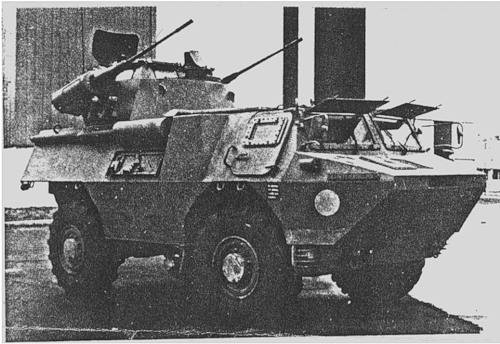
In the middle of the 70s, Thomson-CSF and GIAT created the VAB VADAR light wheel ZSU with 20-mm automatic F2 guns and EMD 20 radar. This anti-aircraft installation was supposed to cover transport convoys from fighter-bomber and combat helicopters, but after the release of a small number of ZSUs in 1986, the order was canceled. Apparently, the military did not accept the small effective range of 20-mm anti-aircraft guns. A 30-mm variant based on a 6 wheeled armored personnel carrier was also considered, but it was not mass-produced as well.
In the 50-ies in the Federal Republic of Germany were supplied twin 40-mm American ZSU M42 Duster. They had a good range, but by the middle of the 60's were outdated due to the lack of a fire control system. In 1976, in the units of the Bundeswehr military air defense, the Dusters began to replace the Gepard ZSU. Self-propelled unit "Cheetah" is armed with two 35-mm automatic guns "Oerlikon" KDA with a rate of fire 550 rds / min, ammunition - 310 unitary projectiles. The mass of the 35-mm projectile is 550 g, which is approximately 5 times the mass of the 20-mm projectile ZSU "Volcano". Due to this, with an initial speed of 1175 m / s, the inclined effective range of fire is 3500 meters. The height of the targets hit is 3000 meters. The fire is from a short stop.
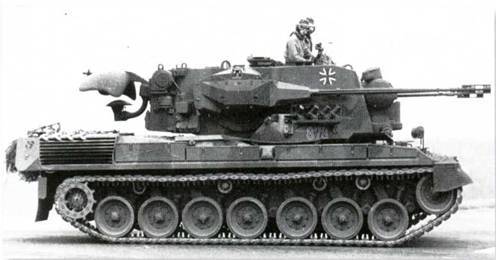
ZSU "Cheetah" was created on the basis of the West German tank "Leopard-1" and by the mass of the component in the combat position 47,3 t was close to him. Unlike the Vulkan ZSU, the West German anti-aircraft gun had a fairly sophisticated search-and-target hardware system. It included: pulse-Doppler detection radar with identification equipment, target tracking radar, optical sight, two analog calculating devices. The detection radar saw aerial targets at a distance of 15 km. In terms of combat characteristics, the ZSU “Cheetah” was significantly superior to the American ZSU “Vulkan”. She had a much better armor protection, long range and the power of the projectile. Due to the presence of its own target radar, it could act autonomously. At the same time, the ZSU “Cheetah” was significantly heavier and more expensive.
In addition to self-propelled anti-aircraft artillery, the 60-80 had a significant number of towed anti-aircraft guns in NATO air defense units in Europe. So, in service with the armies of Germany, Norway, Italy, Turkey and the Netherlands were several hundred 40-mm anti-aircraft guns Bofors L70. Each Bofors anti-aircraft battery had a radar for detecting and tracking a target, with instrumentation for issuing commands to automatic tracking drives of anti-aircraft guns. During the years of production of this anti-aircraft gun, which still remains in service, several variants were created, which differed in the power scheme and sighting devices. The latest modifications of the Bofors L70 have an 330 firing rate per minute of fire and a sloping range of 4500 meters.
In NATO countries, a descendant of the famous Erlikon is still widespread - a product of the Rheinmetall company - the 20-mm paired anti-aircraft gun MK 20 Rh 202. Its deliveries to the Bundeswehr began in the 1969 year. 20-mm towed anti-aircraft installation MK 20 Rh 202 is designed to fight low-flying air attack weapons during the day in simple weather conditions.
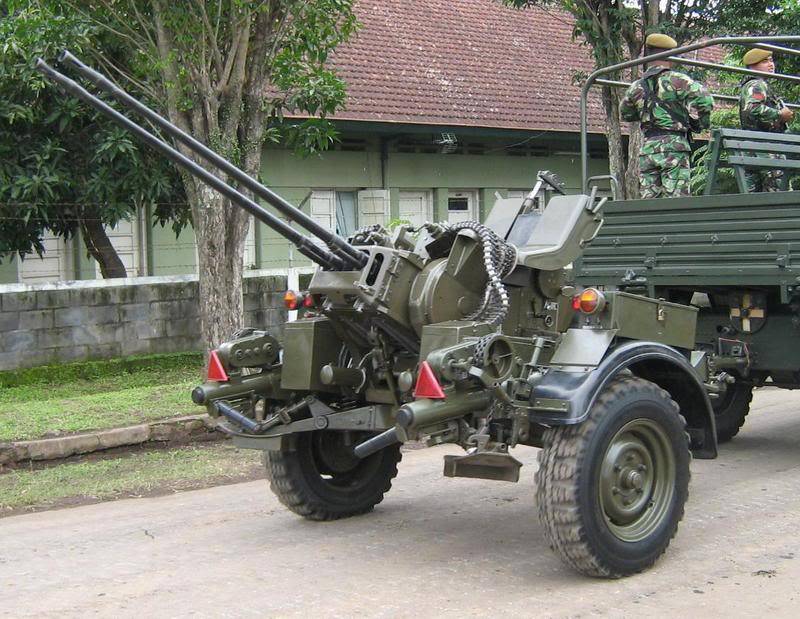
With a combat weight of 1,640 kg, the twin 20-mm anti-aircraft gun has high mobility and can be used both in towed version and on various vehicles. Its effective fire range is 1500 meters. The rate of fire - 1100 shots per minute.
In general, the ground units of NATO in Europe in 70-80-s had a good anti-aircraft cover. Thus, in each American mechanized and armored division deployed in Germany, there was one anti-aircraft division (24 SPU SAM Chaparel and 24 20-mm six-barreled installation "Vulkan").
According to Western analysts, NATO air defense, relying on the Nage information system, interceptor fighters and air defense missile systems, was quite effective against IL-28, Tu-16 and Tu-22 bombers. However, after adopting the Su-24 front-line bombers and Tu-22 long-range bombers with a variable geometry of the wing, the effectiveness of the NATO air defense system in Europe was in doubt. According to Western estimates, new Soviet bombers could fly at altitudes of 50 meters and lower at speeds of 300 m / s. In this case, ground-based means of controlling the air situation experienced great difficulties with their detection. The Nike-Hercules SAM system could not hit air targets at that altitude at all. And the low-altitude Hawk had no time to defeat, since from the moment of detection with its own radar until the target left the affected area, no more than 30 seconds passed.
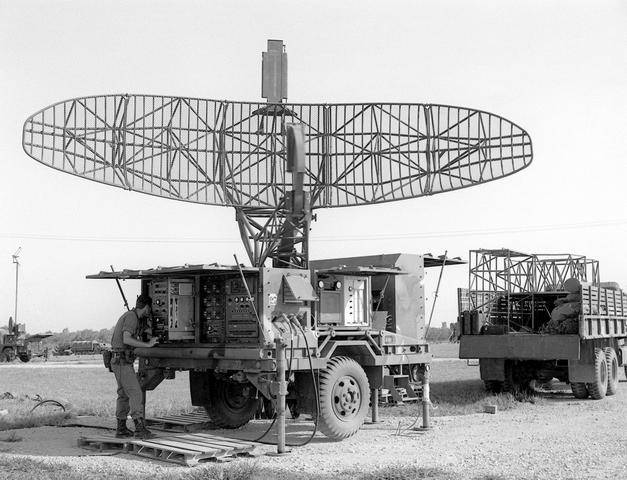
At the end of 70-x - the beginning of 80-x Western European countries invested heavily in improving the regional air defense system. Its gain went in two directions. First of all, the already existing structures, weapons, means of detection and control were improved. The modernization of relatively new radars and long-range air defense systems was carried out through the introduction of computerized automated control systems and high-speed communication lines. First of all, it concerned the stationary radar system "Neydzh" and long-range air defense systems "Nike-Hercules." Radically upgraded complexes were supplied to the anti-aircraft missile divisions: MIM-23C Improved Hawk with the new AN / MPQ-62 detection radar and the upgraded tracking, target illumination and target guidance radar AN / MPQ-57. Due to this, the reaction time of the complex has decreased, and the ability to combat low-altitude targets has increased. A part of the lamp element base was replaced by a solid-state element, which increased the time between failures. The use of missiles with a more powerful engine and sophisticated guidance equipment has increased the target's range to 35 km, and the height to 18 km.
In 1983, the British army air defense units received the improved Tracked Rapier short-range air defense systems, which were designed to accompany tank and mechanized units. On the chassis of the “Tracked Rapier” mounted all the elements of the complex, except for the tracking radar. Significant improvements have been mobile SAM "Chaparrel", "Crotal" and "Roland". Works on their modernization were carried out in the direction of increasing reliability, noise immunity and firing range. SAM "Chaparrel" received a new anti-jamble missiles with a proximity fuze. In 1981, the “Roland-2” air defense system was put into service, capable of fighting air targets at night and in adverse weather conditions. A program to modernize part of the previously built complexes was also carried out. On the first versions of the "Crotal" complex, after the march was completed, a cable docking of the command and control center and launchers was necessary for the transition to the operational position. In 1983, the troops went to the option where information is exchanged between the command post and the launcher at a distance of up to 10 km via radio. All vehicles of the complex are combined into a radio network, it is possible to transfer information to the launcher not only from the command and control point, but also from another launcher. In addition to a significant reduction in the time of bringing the complex into combat readiness and increasing the distance between the command and control facilities and launchers, noise immunity and survival increased. The modernized “Crotal” got the opportunity to conduct military operations without unmasking the turning on of the radar - using a thermal imaging camera that accompanies target tracking and missiles, both during the day and at night.
The European NATO airfields in 80 began to master the new American fighter F-16A, the Italian-British-German interceptor Tornado ADV and the French Mirage 2000. In parallel with the supply of new aircraft, the avionics and the armament of existing F-104 Starfighter, F-4 Phantom II and Mirage F1 fighters were being upgraded. The E-3 “Sentry” aircraft of the AWACS system began to play an important role in ensuring airspace control. Airborne early warning aircraft, deployed on a permanent basis in the UK, Germany and Italy, conducted daily air patrols. Their value was especially great due to the good performance in detecting low-altitude aerial targets.
To be continued ...
Based on:
http://www.zvo.su/VVS/radiolokacionnye-stancii-voyskovoy-pvo-stran-nato.html
http://www.radioweb.ru/avia/pvo/part6.htm
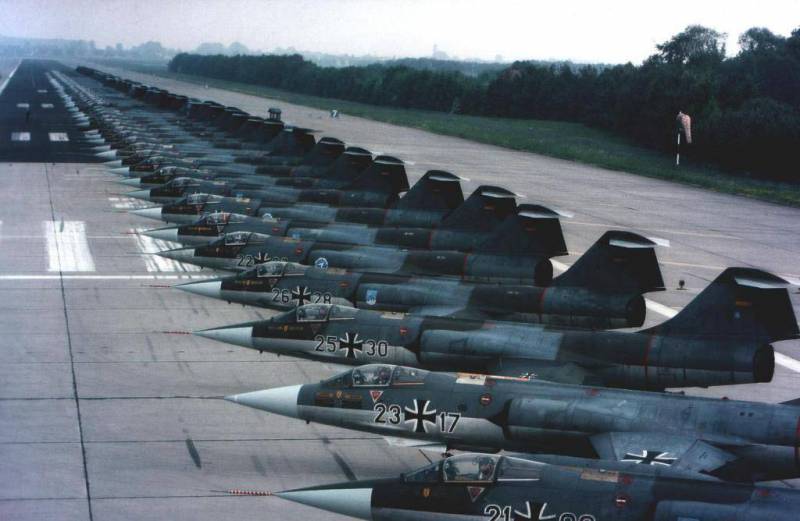
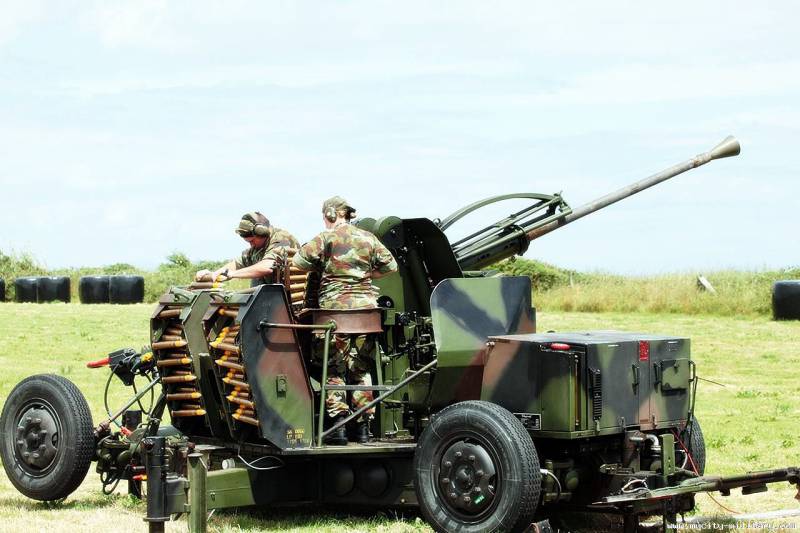
Information